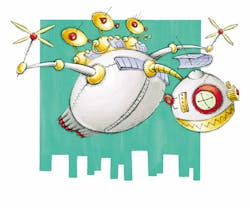New technologies and tools abound. On a numerical basis, India is the largest growth market for cell phones, with 160 million already in use and about 6 million being added every month. Market penetration is still low (less than 20 percent), but projections are for more than 500 million subscribers by the end of 2010. I got my own local cell number, to connect with anywhere in the country, for about 2 cents a minute, with incoming calls free. No one uses voice mail; you quickly get used to text-messaging as an effective alternative. But you also must get used to deleting lots of text advertising. Broadband Internet is everywhere, and I connected quickly and easily with my wireless laptop. There are always some glitches, which take getting used to; but one quickly becomes tolerant of the interruptions. Internet cafes abound, with prices that are ridiculously low translated to dollars. And everywhere, there is the frenetic rush of traffic. Behind this rush is India’s huge middle class—some 400 million—motivated for growth and success. The media is as hyped up as anywhere, perhaps more. On TV, car radios and cell phone media, the sales messages are constant and continuous, catering to that colossal consumer class in multiple languages, all mixed in with English phrases; it’s called Indglish. You witness the upwardly mobile middle-class just gobbling up the plethora of consumer products from Sony, Nokia, Motorola, Samsung and the like. Apart from Bangalore being the headquarters of India’s software giants such as Infosys and Wipro, the large multinationals all have major R&D establishments here. GE’s largest research center outside the United States and SAP’s largest outside Germany are here. Many automation majors have hundreds of design and development employees here too, including Honeywell, Rockwell, Invensys, ABB and others. Interestingly, the local thinking is not just aimed at how to improve outsourcing services, or play consumer catch-up. Strategic plans at many of the growing giants include major new developments where they can lead rather than follow. Next big opportunity The Indian software majors are excited about the next big opportunity that’s waiting to be developed—clean-tech systems. This is the programming and monitoring for the thousands of global companies who, in the next decade, will be launching the drive to become carbon neutral, or far more energy efficient than they are today. They see this need as inevitable; a safe bet rather than a strategic risk. Software companies such as Infosys call this E2K—similar to the label Y2K that accompanied the huge workload of software that came just before the year 2000 to prevent software crashes with the four-digit change. The key to winning E2K business, according to Infosys Chief Executive Officer Nandan Nilekani, will be to show giant global companies such as Wal-Mart how becoming more energy efficient doesn’t have to be a new cost burden. Beyond just improving their image or satisfying regulators, it can be an investment that makes money and gains a financial edge on the competition. The idea is to use energy-related software to reduce material costs, simplify logistics, drive down electricity charges and shorten supply chains. As large companies start to do this, it will require a lot of data management—which is what Infosys and others are focused on. They think the opportunity is huge, and they intend to provide the leadership that will satisfy the demand. Will this new clean-tech demand be satisfied from developers in the United States or Europe? Or, will the technology leadership come from places such as India? Jim Pinto is an industry analyst and commentator, writer, technology futurist and angel investor. You can email him at: [email protected]. Or review his prognostications and predictions on his Web site: www.JimPinto.com.
About the Author
Sign up for our eNewsletters
Get the latest news and updates

Leaders relevant to this article:
